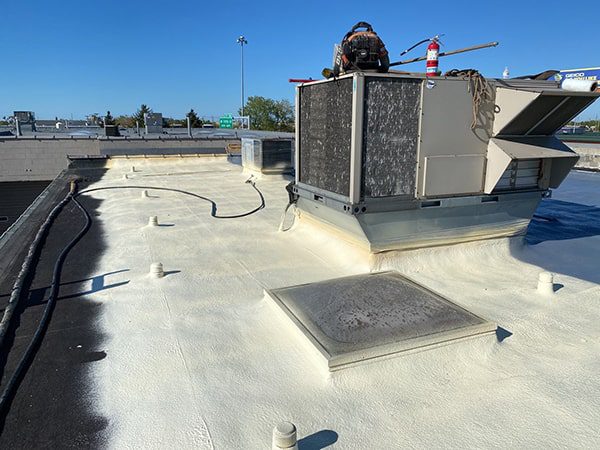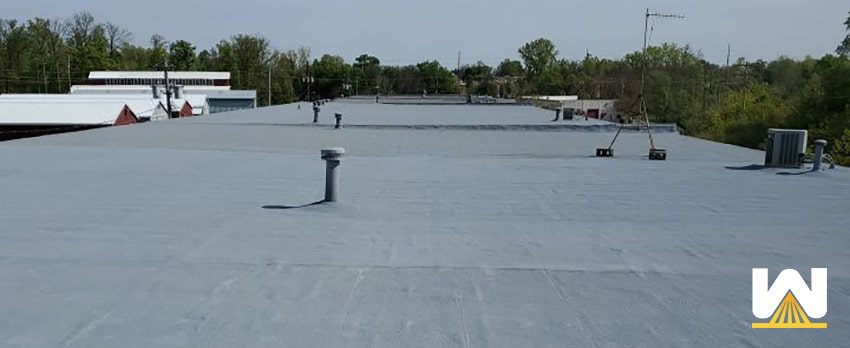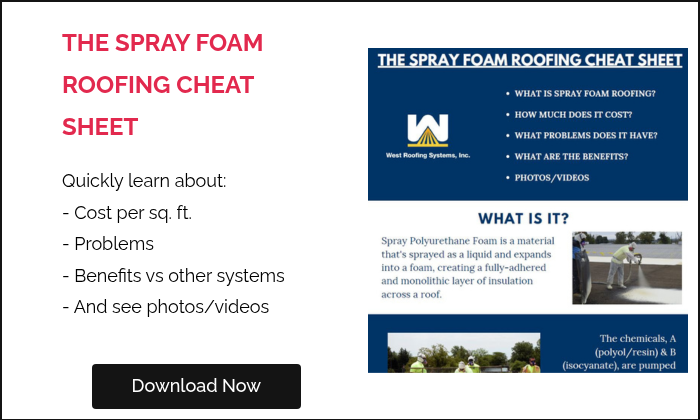Do you have an existing smooth built-up roof?
Or do you have an existing built-up roof with loose rocks/gravel on it?
Either way, if it’s leaking (or is very old) you need a cost-effective repair option.
To get right to the point, if it’s a smooth BUR, you can repair it with a silicone roof coating system.
If it’s a BUR with loose rocks, you can repair it with a spray foam roofing system.
In this article, you’ll learn:
- What is a built-up roofing system?
- How BUR’s leak?
- Why BUR’s aren’t installed anymore?
- How spray foam is a cost-effective repair option for non-smooth BUR’s?
- How is spray foam installed?
- How silicone roof coating systems are cost-effective repair options for smooth BUR’s?
And just so you’re aware, we only write articles based on true events and experiences. Every piece of content written at West Roofing Systems is produced in-house. And every article is reviewed and edited by a roofer/salesman with more than 30+ years of experience in the field.
Let’s get started!
What is a Built-up roofing system?
Built-up Roofing (BUR) systems are commonly referred to as “tar and gravel” roofs.
Built-up roofs are installed by alternating layers of asphalt or tar and supporting fabrics directly onto the roof. You can choose the number of layers (or plies) that are installed. The final layer of a built-up roofing system consists of stone or gravel.
BUR’s come in smooth and granulated. The difference is the final layer. On a smooth BUR, the final layer is tar. On a granulated BUR, the final layer is manufactured with granules embedded into the sheet.
How can BUR’s leak?
There are several ways built-up roofs can leak, including:
- Flashings around the perimeter of the roof degrade
- Flashings around penetrations degrade
- Foot traffic has pushed gravel too deep into the roof layers
- The tar has degraded from UV rays
- The roof has been neglected, drains are clogged, and standing water has degraded the roof
Built-up roofs are among the best roofing systems against leaks. With so many layers, it’s hard for water to make its way into the building, but it does happen.
Why Built-up roofs aren’t installed anymore?
A few BUR owners have asked us “Why aren’t these roofs installed anymore?” No one knows the real answers why, but it could be due to:
Cost
Perhaps the materials that are used to produce other roofing systems are more cost-effective.
New technology forcing BUR out of the industry
Many building owners are interested in single-ply’s, metal roofing, silicone coating systems, or spray-on roofing.
Lack of materials
Are tar and gravel hard to find? If so, it could be a reason installation rates are down.
No contractors interested in dealing with it
It’s messy and it can be a fire hazard. Two good reasons contractors aren’t interested in installing BUR’s.
If you have a Built-Up Roof, what repair options do you have?
The first option is a spray foam roofing system.

BUR owners find spray foam roofs attractive because:
- Tear-off is minimized
- You get to maintain a seamless membrane
- It adds a significant amount of R-value (6.5 per inch of thickness)
- Spray foam includes closed-cell insulation
- The roof will be sustainable and renewable once the warranty expires
How is a spray foam roof installed on a BUR?
Step 1 – Remove loose rock, gravel, and debris
The first step is to get rid of anything that isn’t fully adhered to the membrane, which is the loose rocks and gravel. A roofing contractor will do this using a wet-vac system.
Step 2 – Remove wet insulation
If your BUR is leaking, water has infiltrated the membrane, saturated the insulation, and has made its way into your building.
Before you install any new roofing system, it’s highly recommended to remove all the wet insulation. This is to remove all the existing moisture. If the moisture isn’t removed, this can cause issues with blisters, continual leaking, and other issues that should be prevented.
A roofing contractor identifies wet insulation through the pulling of core samples, visual inspections, or thermal imaging.
Once all the wet insulation is removed, new, dry insulation is installed.
Step 3 – Clean the membrane
The next step is to make sure spray foam has a SUPER clean membrane to spray onto.
One of the owners at West Roofing Systems has said that before spraying any foam, the existing roof should be so clean that you wouldn’t think twice about picking it up and eating it even if you dropped your sandwich on it.
Roofing contractors use power washing to rid existing roofs of any loose contaminants.
Step 4 – Apply spray foam
The fun finally begins!
Spray foam contractors apply the product to the existing roof. If you’ve never seen spray polyurethane foam installed, here’s a video showing you how that’s done:
Spray foam’s thickness level is customized to each job depending on the R-value desired by the building owner.
The thickness level is also customized to make sure there’s proper sloping. This is to eliminate standing/ponding water.
Step 5 – Apply base coat and top coat of coating
One weakness of spray foam is that UV rays will degrade it within 72 hours. To protect the foam, an elastomeric coating is installed over top.
Most contractors use silicone as their choice of elastomeric coating. This is because silicone is waterproof, has a fast cure time, has good elongation and elasticity, and performs great in any climate.
The thickness of coating varies with the desired warranty:
- For a 10-year warranty, 20 mils of coating will be installed
- For a 15-year warranty, 25 mils of coating will be installed
- For a 20-year warranty, 30 mils of coating will be installed
Step 6 – Apply granules
Once the base coat of coating is installed and cured, the top coat is installed.
Granules are embedded into the top coat to increase the strength of the roof.
A second repair option is a silicone roof coating system
If you have a smooth BUR, an alternative repair option is a silicone roof coating system. The system is applied the same as a spray foam roof, without installing the foam.
If you have a gravel BUR, which is embedded rock or loose gravel that is inserted into the final layer of tar, creating a “rocky” surface. A coating system is not recommended.
One option is a re-saturation of tar and gravel, not many companies that are out there do that anymore. And if not done correctly could result in a leaky roof repair.
A more cost-effective option would be a spray foam roof.
What should a BUR building owner do now?
If you have an older (or leaking) built-up roof, the best thing to do is to contact a commercial roofing contractor.
Why?
Because they can give you different repair options.
Someone might recommend a single-ply roof.
Someone might recommend spray foam.
Someone might tell you that you have 2 good years remaining on the roof.
The great thing is that since you’re the building owner, you have the power to compare, ask questions, and choose the right solution for you.
West Roofing Systems specializes in solving problems for existing roofs. Since we’ve been in business since 1979, every roof we see has something different.
But we love the challenge of seeing a roof, seeing how it’s designed, asking the building owner questions about their goals, and then coming back with the best solution.


